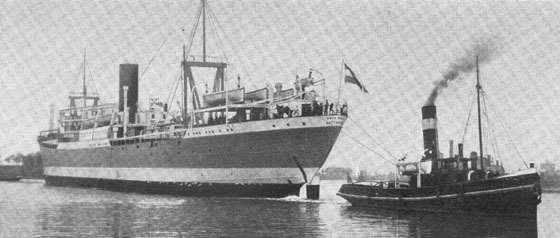
A series of eight cargo / passenger vessels were ordered for the Rotterdam Lloyd Line for use on the fast cargo service from Rotterdam to the Dutch East Indies. Although primarily cargo carriers they also carried accommodation for about twenty eight passengers and when used on the pilgrim services between Indonesia & Saudi Arabia would transport up to two thousand pilgrims.
Of the eight ships three were built at Royal Schelde in Flushing and these were all fitted with Sulzer engines. These three ships were the Kota Baroe, Kota Radja and Kota Napon (construction No. 182, 183 & 187). Each side of the engine room were fuel bunkers with a capacity of 1,600 tons, providing sufficient capacity for a Holland - Java round trip. All the auxiliary machinery was electrically operated, although a donkey engine was fitted for heating purposes. Two derricks capable of lifting 40 tons were fitted along with eight 5-ton winches and four capable of lifting 3 tons. There were four main holds and eight tanks capable of holding 1,600 tons of vegetable oil. Limited refrigerated space was available for cargo & stores. The whole of the double bottom is designed for the carriage of water ballast apart from one tank holding drinking water.
Kota Radja (7,177 tons)
The Kota Radja commenced express cargo service between Hamburg, Rotterdam and Batavia, Surabaya on November 5th 1927.
The ship was taking on a load of rubber at Surabaya on February 24th 1942 when Japanese aircraft attacked, bombs set the ship on fire, the ship remained afloat but was a total loss, it was towed out to sea and scuttled by an RNN minelayer.
Kota Baroe (7,307 tons)
The Sulzer engine was similar to that fitted to the Kota Radja Baroe but delivering 5,500hp at 100rpm
On January 18th 1941 the naval vessel Java provided protection for a small convoy from the Ajoe archipelago with four merchant vessels including the Kota Baroe, Kota Nopan and the Kota Tjandi. The convoy was dissolved on January 23rd 1941 in position 03.00 South, 161.25 East.
On June 6th 1941 the USA's Ship Requisition Act permitted the seizure of eighty four voluntarily inactive large ships of foreign registry in American ports. The Dutch Ministry of Shipping cooperated with the War Department to allow further use of the Kota Baroe, Kota Agoeng and Kota Inten.
The Kota Baroe carried a cargo of airplanes from the USA to Tjilatjap, arriving there on February 27th 1942. These were aircraft for use by the authorities in the Netherlands East Indies. The advancing Japanese forces caused future aircraft deliveres from the USA to be made to Australian ports to prevent the aircraft from almost immediately falling into enemy hands. These aircraft were mainly Mitchell bombers, P-40N fighters and Lodestar transports. At least six aircraft were carried by the Kota Baroe, these were Douglas DB-7B's. The delivery of these crated aircraft to Tjilatjap so close to the capitulation of the country only saw one of the crated aircraft made flyable, the remainder were captured by the Japanese virtually still in their crates.
March 22nd 1944 saw the Kota Baroe crossing the Pacific from the United States to Finschafen, New Guinea.
The Kota Baroe sailed from San Francisco July 9th 1944 bound for Pearl Harbor and arriving there on July 16th 1944.
On October 15th 1944 the Kota Baroe sailed from Guam to Kahalui, Maui arriving there on November 1st 1944.
After the end of World War Two the Kota Baroe was returned to Dutch Government in 1946, following this it was returned to its owners in 1948.
1950: May 8th at Melbourne from Marseilles.
1950: June 3rd at Melbourne for Sydney, arrive Sydney June 5th.
1950: June 15th at New Caledonia.
1950: June 21st at Sydney for Brisbane.
It was scrapped in Hong Kong during 1957.
Kota Napon (7,319 tons)
The Kota Nopan was delivered in 1931. During 1941 it was captured by a German surface raider and converted to supply ship. In 1943 it was scuttled off Brazil to avoid capture by the US Navy.
Basic Details (Kota Radja, others similar)
Built: K.M. de Schelde, Flushing
Launched: 1927
Tonnage: 7,177 tons
Deadweight: 9,500 tons
Length: 466 feet
Breadth: 60 feet
Draught: 33 feet
Propulsion: One eight cylinder Schelde-Sulzer 8S76 engine developing 5,200hp at 95hp (760mm bore, 1,360mm stroke)
Auxiliaries: Three x 4KS31 engines developing 180hp each at 300rpm.
Screws: 1
Speed: 14.5 knots
![]()
There were five other vessels in this series, but these were all powered by MAN engines:
Kota Agoeng:
Builder: Fijenoord Co; Engine: MAN, delivered 1930. During 1942 it was taken over as US Army troopship, 1946 returned to owners, 1958 scrapped Hong Kong. 7,358 tons.
Kota Gede:
Builder: Fijenoord Co; Engine: MAN, delivered 1928. Chartered for use by the USA in 1942, returned to owners in 1946, 1958 scrapped Hong Kong. 7,323 tons.
Kota Inten:
Builder: Fijenoord Co; Engine: MAN, delivered 1927. Taken over by US War Shipping Admininstration in 1942 for troopship service, during 1946 it was returned to the Dutch Government, then returned to its owners in 1951, 1957 scrapped Hong Kong. 7,191 tons.
Kota Pinang:
Builder: Netherland Shipbuilding & Eng. Co; Engine: MAN, delivered 1930. In 1940 it was captured by the Germans at Rotterdam and was renamed Klara, converted to U-Boat supply ship and eventually sunk by HMS Kenya near the Azores. 7,200 tons.
Kota Tjandi:
Builder: Fijenoord Co; Engine: MAN, delivered 1930, during 1943 it was chartered to the Ministry of War Transport, London. Later torpedoed and sunk by a U-Boat off Freetown with the loss of six lives. 7,309 tons.
![]()
Page added September 15th 2007.
Last updated April 1st 2012.
Return to Ship menu
Return to site menu